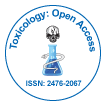Understanding Neurotoxicology Mechanism Assessment and Implications
Received: 01-May-2024 / Manuscript No. tyoa-24-131766 / Editor assigned: 03-May-2024 / PreQC No. tyoa-24-131766 (PQ) / Reviewed: 17-May-2024 / QC No. tyoa-24-131766 / Revised: 20-May-2024 / Manuscript No. tyoa-24-131766 (R) / Published Date: 27-May-2024
Abstract
Neurotoxicology is a branch of toxicology focused on understanding the adverse effects of chemicals on the nervous system. It encompasses a wide range of substances, from environmental pollutants to pharmaceuticals, and investigates their potential to cause neurological damage. This review article provides an overview of neurotoxicology, including its underlying mechanisms, methods of assessment, and implications for human health. By exploring the intricate relationship between toxicants and the nervous system, this paper aims to enhance our understanding of neurotoxicity and inform strategies for prevention and intervention.
keywords
Neurotoxicology; Nervous system; Toxicants; Assessment
Introduction
The nervous system plays a critical role in coordinating bodily functions and facilitating communication between various organs and systems. As such, any disruption to its function can have profound implications for health and well-being. Neurotoxicology is the field dedicated to studying the adverse effects of chemical substances on the nervous system, encompassing both acute and chronic neurological disorders. Understanding neurotoxicity is essential for safeguarding public health and developing effective strategies for risk assessment and management [1-3].
Methodology
Mechanisms of neurotoxicity
Neurotoxicity can occur through various mechanisms, depending on the nature of the toxicant and the target site within the nervous system. Common mechanisms include oxidative stress, inflammation, excitotoxicity, and disruption of neurotransmitter systems. Oxidative stress, characterized by an imbalance between reactive oxygen species (ROS) and antioxidant defenses, can lead to neuronal damage and cell death. Inflammation, mediated by immune responses within the central nervous system, can exacerbate neuronal injury and contribute to neurodegenerative diseases. Excitotoxicity refers to the excessive activation of glutamate receptors, leading to neuronal hyperexcitability and cell death. Disruption of neurotransmitter systems, such as dopamine, serotonin, and acetylcholine, can impair cognitive function, mood regulation, and motor control [4-6].
Assessment of neurotoxicity
Assessing neurotoxicity involves a multidisciplinary approach, combining in vitro, in vivo, and epidemiological studies to evaluate the effects of toxicants on the nervous system. In vitro assays utilize cell cultures or neuronal models to screen for neurotoxic effects and elucidate underlying mechanisms. In vivo studies involve animal experimentation to assess neurobehavioral outcomes, neuropathological changes, and biochemical alterations following exposure to toxicants. Epidemiological studies examine the association between environmental exposures and neurological outcomes in human populations, providing valuable insights into potential risks and health effects. Neuroimaging techniques, such as magnetic resonance imaging (MRI) and positron emission tomography (PET), offer non-invasive methods for detecting structural and functional changes in the brain associated with neurotoxicity [7-9].
Implications for human health
Neurotoxicity poses significant risks to human health, particularly vulnerable populations such as children, pregnant women, and the elderly. Developmental exposure to neurotoxicants can disrupt brain development and lead to long-term cognitive deficits, learning disabilities, and behavioral disorders. Occupational exposure to neurotoxic chemicals can result in neurobehavioral impairments, including memory loss, attention deficits, and motor dysfunction. Environmental pollutants, such as heavy metals, pesticides, and air pollutants, have been linked to an increased risk of neurodegenerative diseases, including Alzheimer's disease, Parkinson's disease, and amyotrophic lateral sclerosis (ALS). Recognizing the neurotoxic potential of various substances is essential for implementing preventive measures, establishing regulatory guidelines, and promoting public health policies aimed at reducing exposure and minimizing harm [10].
Conclusion
Neurotoxicology plays a crucial role in identifying and mitigating the adverse effects of chemical substances on the nervous system. By elucidating the underlying mechanisms of neurotoxicity and developing reliable methods for assessment, researchers can enhance our understanding of neurological disorders and inform strategies for prevention and intervention. Continued interdisciplinary collaboration and advances in technology are essential for addressing the complex challenges posed by neurotoxicity and safeguarding the health and well-being of individuals and communities worldwide.
References
- Hong Ji, Huang W, Xing Z, Zuo J, Wang Z, et al. (2019) Experimental study on removing heavy metals from the municipal solid waste incineration fly ash with the modified electrokinetic remediation device. Sci Rep 9: 8271.
- Le Borgne S, Paniagua D, Vazquez-Duhalt R (2008) Biodegradation of organic pollutants by halophilic Bacteria and Archaea. J Mol Microbiol Biotechnol 15: 74-92.
- Agamuthu P, Abioye OP, Aziz AA (2010) Phytoremediation of soil contaminated with used lubricating oil using Jatropha curcas. J Hazard Mater 179: 891-894.
- Bergerson JA, Keith D (2010) The truth about dirty oil: is CCS the answer? Environ Sci Technol 44: 6010-6015.
- Carlson HK, Stoeva MK, Justice NB, Sczesnak A, Mullan MR, et al. (2015) Monofluorophosphate is a selective inhibitor of respiratory sulfate‐reducing microorganisms. Environ Sci Technol 49: 3727-3736.
- Gokulakrishnan K, Balamurugan K (2010) Influence of seasonal changes of the effluent treatment plant at the tanning industry.Int J Appl Environ 5: 265-271.
- Alain M (2007) Environmental noise, sleep and health. Sleep Med Rev 11: 135-142.
- Curtis L, Stuart B, Martin W (2001) Noise Monitoring at Glastonbury Festival. Noise Vib Worldw 32: 12-14.
- Dias RL, Ruberto L, Calabró A, Balbo AL, Panno MT, et al. (2015) Hydrocarbon removal and bacterial community structure in on-site biostimulated biopile systems designed for bioremediation of diesel-contaminated Antarctic soil. Polar Biol 38: 677-687.
- Ondra S (2004) The behavior of Arsenic and geochemical modeling of arsenic enrichment in aqueous environments. J Appl Geochem 19: 169-180.
Indexed at, Google Scholar, Crossref
Indexed at, Google Scholar, Crossref
Indexed at, Google Scholar, Crossref
Indexed at, Google Scholar, Crossref
Indexed at, Google Scholar, Crossref
Citation: Anurag K (2024) Understanding Neurotoxicology Mechanism Assessmentand Implications. Toxicol Open Access 10: 270.
Copyright: © 2024 Anurag K. This is an open-access article distributed under theterms of the Creative Commons Attribution License, which permits unrestricteduse, distribution, and reproduction in any medium, provided the original author andsource are credited.
Share This Article
Open Access Journals
Article Usage
- Total views: 418
- [From(publication date): 0-2024 - Apr 02, 2025]
- Breakdown by view type
- HTML page views: 220
- PDF downloads: 198
